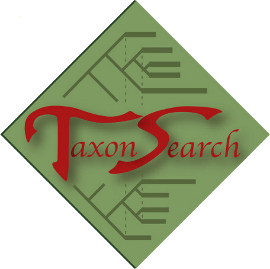Browsing/Searching/Summarizing Taxon Records
Entering TaxonSearch opens the Archive page, which lists the available compilation, their authors and date of posting. Selecting a comliation opens the home of that compilations, which lists pertinent information, such as the identity of the compliler, number of records, and any special notes or acknowledgements. The navigational sidebar on the left allows the user to browse, search or graphically summarize taxon records in the compilation (Browse, Search, Summarize). Alternatively, the user can view tables, graphics or literature citations associated with the compilation (Graphics, Tables, Literature Cited).
The Taxon Record
Each taxon record in a TaxonSearch compilation is divided into six sections with the following features:- Clade-Offers subdivision of taxon records into the subclades listed.
- Taxon-Repository for basic author information, status of the taxon (active, inactive), and comments by the compiler regarding historical usage or choice of phylogenetic definition.
- Active Phylogenetic Definition-Repository for definitional information for active taxa.
- Inactive Taxon Status-Repository for information regarding inactive taxa.
- Current Age Range-Best estimate of the temporal duration of a taxon.
- Definitional History-Repository for all previous phylogenetic definitions for a taxon.
Searching
A practically infinite number of queries about authors, taxa, dates, definitions, and literature citations can be launched using the Search function in the navigational sidebar. Search for a particular taxon or sort taxon records by inputing data in one or more fields, and clicking the "search" button. TaxonSearch finds all matching records. The following example searches are based on the compilation Stem Archosauria 1.0 (Sereno, 2005; Sereno, in review; Sereno et al., in review):Example 1. Entering "Pred" in the Taxon field locates the taxon record for Predentata, a taxon coined by Marsh (1894) that has fallen from use and is generally regarded as equivalent to Ornithischia. The user learns from the Comments field in the Taxon section that "This taxon has not been widely used during the twentieth century despite an attempt by Bakker (1986) to revive it as a replacement for Ornithischia Seeley 1888." The user also learns that Hennig (1915) introduced a spelling variant (Praedentata), that no phylogenetic definition has ever been proposed, and that the compiler (P. Sereno) regards the taxon as a potential synonym of Ornithischia. The taxon is considered inactive.
Example 2. If the user remembers a nominal author (e.g. O. C. Marsh) and was wondering how many taxa were coined by this author within Archosauria, entering "Marsh" in the Nominal Author field in the Taxon section sorts 67 records. If the user wants to determine how Marsh's taxa have faired in the current literature, selecting the active radio button in the Taxon Status field in the Taxon section. TaxonSearch finds 22 records-meaning that 22 suprageneric taxa coined by O. C. Marsh are regarded as active by the compiler, whereas 45 have fallen from use for various reasons. If the user wants to determine if any of Marsh's taxa apply to crurotarsal archosaurs rather than dinosaurs and closest of kin, "Archosauria: Crurotarsi to Crocodylia" can be selected in the Subclade field in the Clade section and "Marsh" entered into the Nominal Author field in the Taxon section. O. C. Marsh proposed three suprageneric taxa among crurotarsal archosaurs (Belodontia, Hallopoda, Hallopodidae), none of which are in current use or regarded as active by the compiler.
Example 3. Finding the taxon record for Ceratopsidae in the compilation Stem Archosauria 1.0 requires input of at least "Ceratopsid" in the Taxon field in the Taxon section. Inputting only "Ceratops" yields six taxon records, which may be of interest (Ceratopsia, Ceratopsoidea, Ceratopsidae, Ceratopsoidae, Ceratopsinae, Ceratopsomorpha). Searches of this kind can locate related taxa. Initiating a search with "Dino" in the Taxon field sorts four taxon records (Dinosauria, Dinoaves, Dinosauriformes, Dinosauromorpha). Selecting only the active button in the Taxon section sorts 181 out of 771 taxon records. Thus taxa commonly used and considered active by the compiler comprise less than one-quarter of all suprageneric taxa that have ever been proposed for the clades under consideration.
Example 4. Initiating a search with "Marsh" in the nominal author field in the Taxon section sorts 67 taxon records (67 taxa authored by Marsh). Initiating a search that also selects the active button in the Taxon section sorts only 22 records. In other words, only one-third of the suprageneric taxa coined by O. C. Marsh (mostly within Dinosauria) are considered by the compiler as active taxa with phylogenetic definitions. The remaining two-thirds are redundant or otherwise have fallen from use. One could quickly review either group of taxon records by sorting them and flipping through their respective records.
Example 5. Marsh named Allosauridae in 1878, the taxon record for which can be rapidly located by TaxonSearch. Graphical representation of this stem-based taxon is accessed by selecting Graphics from the navigational sidebar. Full bibliographic references to Marsh's paper is accessed by selecting Literature Cited from the same navigational sidebar. By scrolling in the taxon record to the Current Age Range section, the current estimated age range for Allosauridae (44 million years; using the most recent temporal records and time scale) is accessible. In the Definitional History section, it is possible to see that three phylogenetic definitions have been previously proposed for Allosauridae, the first in 1997. The user can compare the active definition and read under Comments how the compiler synthesized this historical record.
If the user observes incomplete or incorrect data or prefers to express a differing viewpoint, it is possible to post a comment via email by selecting the Feedback link in any section of the taxon record.
References
| P. C. Sereno. 2005. | The logical basis of phylogenetic taxonomy. Systematic Biology 54:595-619. |
| Sereno, P. C. in review. | A phylogenetic taxonomy for stem Archosauria (Tetrapoda: Reptilia). Journal of Vertabrate Paleontology. |
| Sereno, P. C., McAllister, S., and Brusatte, S. L. 2005. | TaxonSearch: a relational database for suprageneric taxa and phylogenetic definitions. PhyloInformatics 8:1-21. |







